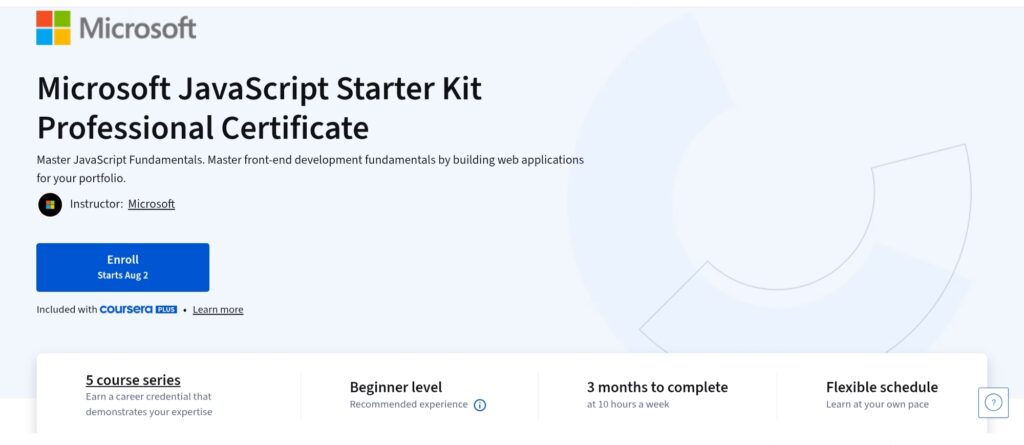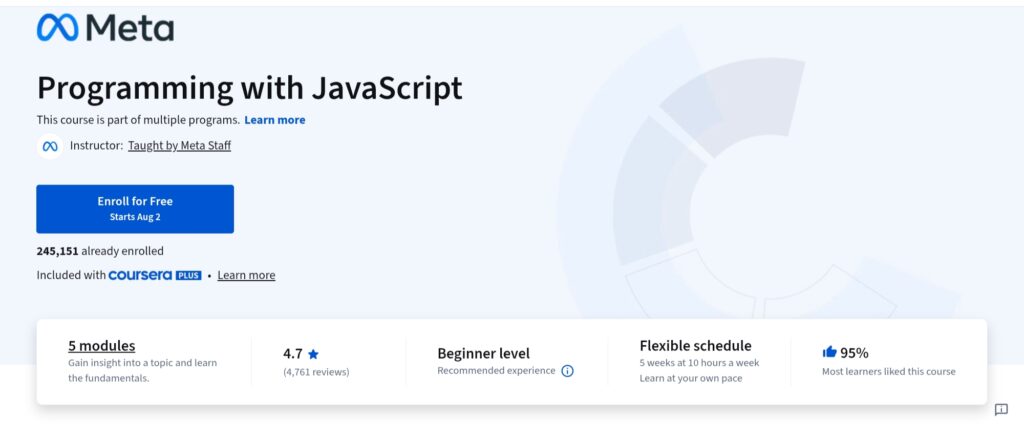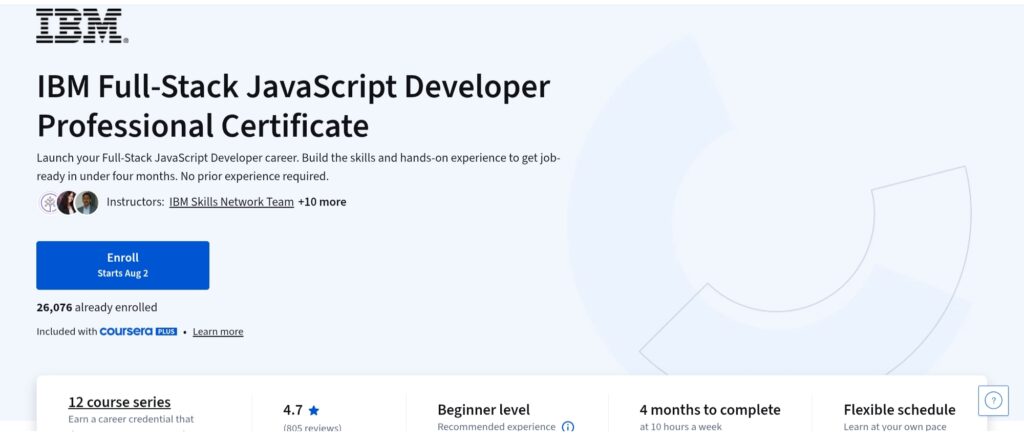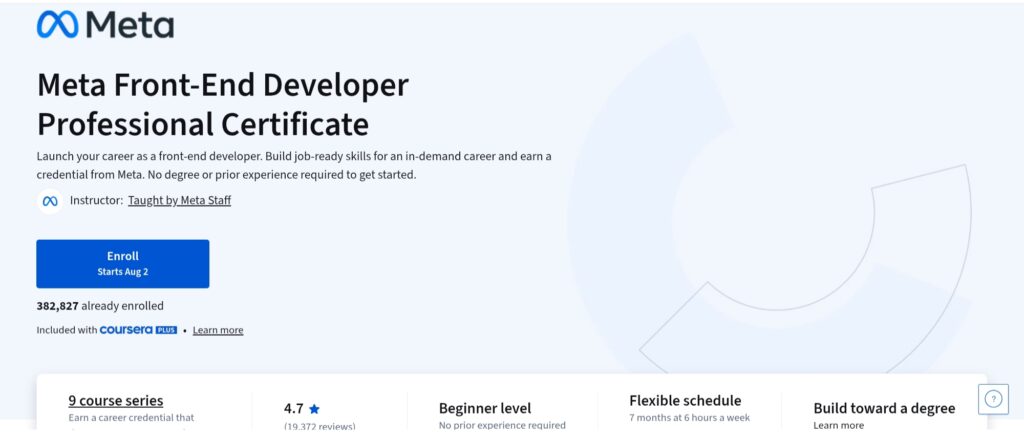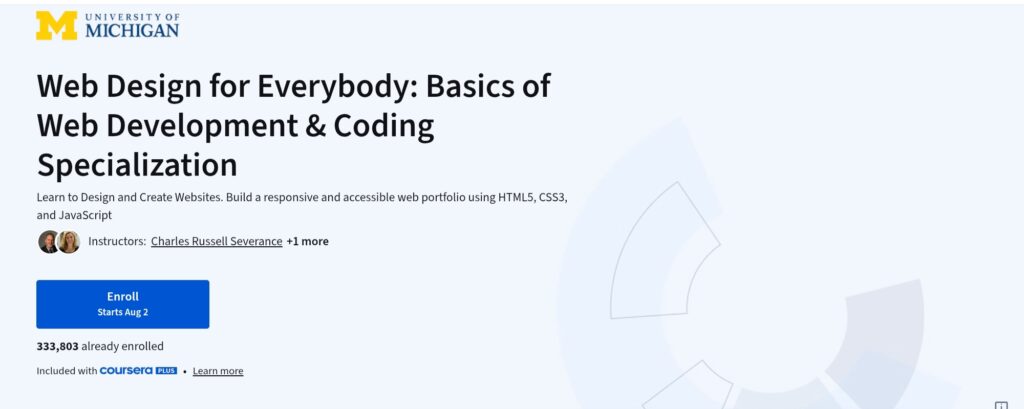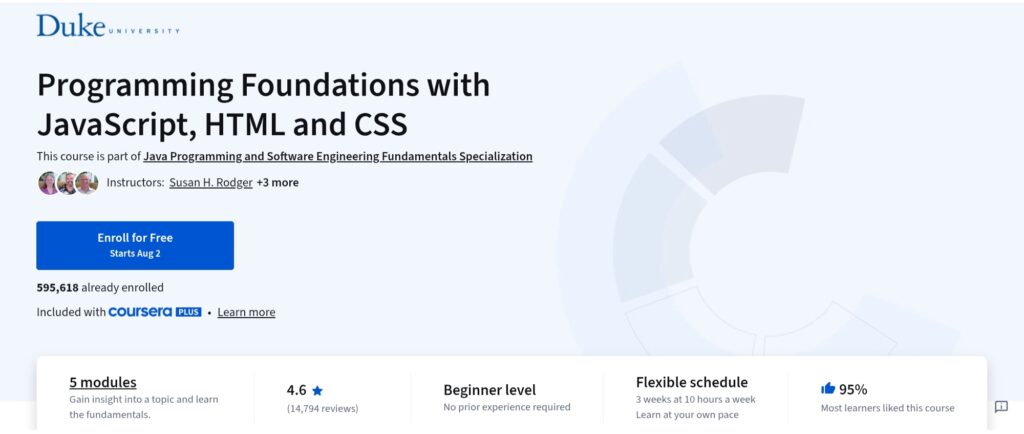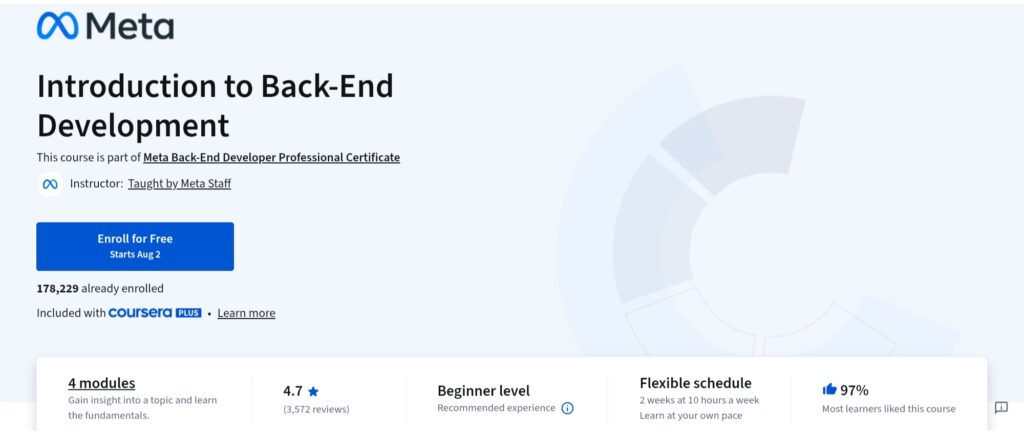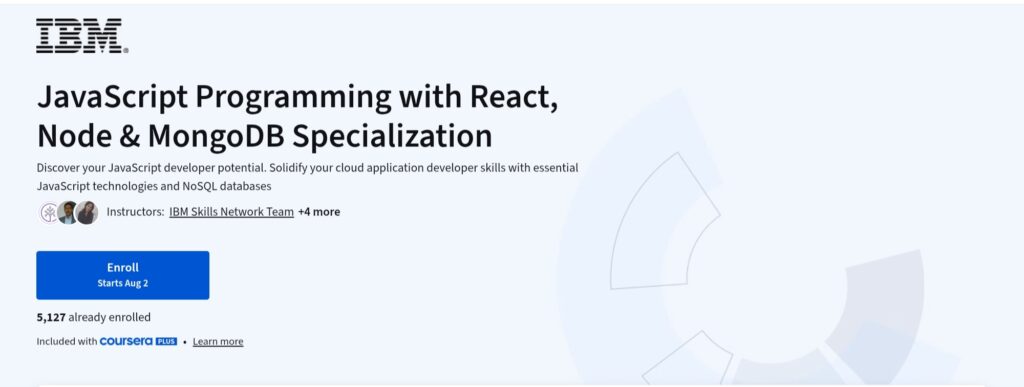Discover the top 10 JavaScript courses on Coursera for beginners and aspiring developers. Explore expert reviews, course highlights, and tips to choose the right JavaScript program for your coding goals.
The foundation of contemporary web development is JavaScript. JavaScript is the language that makes your ideas come to life, whether you’re creating full-stack platforms, single-page apps, or interactive webpages.
Learning JavaScript is crucial for anyone wishing to work in the tech industry because it is used in everything from managing user interactions to executing asynchronous API requests.
However, it can be difficult to choose the best online course because there are so many available. A well-designed course can be the difference between having trouble with complex syntax and being able to confidently create apps for the real world. For this reason, choosing the appropriate learning route is essential to your success.
So why Coursera? Coursera provides access to courses created by prestigious colleges like Duke and Johns Hopkins, as well as tech behemoths like IBM and Meta, in contrast to many other platforms.
Along with excellent teaching, you also receive industry-recognized certificates that significantly boost your resume’s value. Additionally, a lot of courses include practical assignments, tests, and peer support to help you retain what you’ve learned.
This article is designed for –
- Novices who are only beginning to work with JavaScript,
- In order to establish a strong foundation as aspiring front-end and back-end developers,
- Additionally, professionals who wish to improve their JavaScript abilities in order to remain competitive in the job market are known as upskillers.
We’ve examined and carefully chosen the top 10 JavaScript courses on Coursera to help you get started quickly and succeed, whether your goal is to update your development skills or pursue a new job.
What to Look for in a JavaScript Course
It’s crucial to understand what makes a decent course different from a great one before signing up for a JavaScript course. With so many alternatives, choosing a course that fits your objectives and learning style can be made easier by concentrating on a few important characteristics.
Clear Learning Objectives
Both fundamental and contemporary subjects should be covered in a well-designed JavaScript course. Seek out courses that provide –
- Fundamental data structures and syntax
- Using DOM modification to communicate with websites
- Features of ES6+, such as modules, destructuring, and arrow functions
- Promises, async/await, and APIs in asynchronous programming
These are necessary abilities for anyone wishing to create practical web applications.
Hands-On Projects & Assignments
Though theory is useful, hands-on experience is the best way to learn JavaScript. The best courses on Coursera allow you to apply what you learn in real-world situations through capstone projects, coding exercises, and mini-projects. Making your own apps provides you with a portfolio to present to prospective companies and helps reinforce topics.
Instructor Reputation and Affiliation
Acquiring knowledge from reliable sources has an impact. Prominent academic institutions like Duke, the University of London, and Johns Hopkins, and tech firms such as Google, IBM, and Meta are partners of Coursera.
Skilled educators with solid academic or professional credentials guarantee that the content is current and pertinent.
Course Difficulty Level
Pick a course that matches your current skill level:
- Beginner: No coding background needed
- Intermediate: Some knowledge of programming or web basics
- Advanced: Designed for experienced developers wanting to deepen their JavaScript expertise
Duration, Flexibility & Certification
Most Coursera courses are self-paced, allowing you to learn around your schedule. Check the estimated duration and see if the course offers flexible deadlines, shareable certificates, and opportunities to pause/resume as needed.
This is especially helpful for working professionals and students with tight schedules.
Peer Reviews and Ratings
Lastly, pay attention to the reviews. Coursera student reviews can help you understand how well-organized the course is, whether the information is current, and the actual benefit that students received from finishing it. A safer option for high-quality education is a course with a high rating and glowing reviews.
Access 10,000+ Courses on Coursera with Coursera Plus Subscription.
List of the Top JavaScript Courses on Coursera
1. JavaScript for Beginners Specialization
Instructor / Institution
William Mead via UC Davis
Target Audience
Absolute beginners or career changers with little to no programming background.
Duration & Level
Approximately 6–8 weeks at around 10 hours per week. The entire specialization is beginner-level and self‑paced.
See the Web Story – JavaScript for Beginners Specialization
What You’ll Learn (Key Topics / Modules)
Fundamentals of JavaScript: variables, arrays, simple loops, control structures, and code editor use.
JavaScript and jQuery animation: DOM manipulation, user interface animations, and the basics of jQuery.
JavaScript and jQuery interactivity: sophisticated jQuery plugins, event-driven user interface, and simple game-style logic.
JavaScript data manipulation encompasses arrow functions, asynchronous programming, event loops, data validation, creating a reservation system, and utilizing AJAX to fetch external data.
Unique Highlights
Real-world mini-projects, such as an interactive system for booking seats.
Four structured courses that gently progress from syntax to data management.
A focus on using JavaScript and jQuery together to create animations and interactive elements quickly.
Quizzes and challenges with modest stakes and a learner-friendly pace
Who Should Take It
This specialization is perfect if you’re new to programming and want to gain a solid foundation in traditional JavaScript and jQuery operations. It is ideal for students who wish to finish a full learner track with a valid career diploma, prefer practical projects, and work at a steady pace.
2. Microsoft JavaScript Starter Kit Professional Certificate
Instructor / Institution
Microsoft (Professional Certificate, 5-course series)
Target Audience
Beginners with no prior coding experience, as well as those with some programming background who wish to solidify JavaScript fundamentals for real-world web development roles.
Duration & Level
Typically a 3–4 month commitment, self-paced, and beginner-level. Includes a series of five structured courses.
See the Web Story – Microsoft JavaScript Starter Kit Professional Certificate
What You’ll Learn (Key Topics / Modules)
During the five classes, you will learn the following.
Overview of JavaScript: Building a text-adventure game is the last step. Other topics covered include core grammar, variables, arrays, loops, conditionals, debugging, and best practices for coding.
Web development basics include form validation, DOM event handling, responsive CSS, semantic HTML, and a To-Do List application that is ready for a portfolio.
Modern patterns, API integration, testing techniques, app architecture, and deployment procedures are all covered in JavaScript Data and Applications.
Unique Highlights
You can develop a foundation that is ready for your portfolio by working on real-world projects like an interactive To-Do app and a text-adventure game.
Curriculum bearing the Microsoft trademark guarantees conformity to industry norms.
A focus on deployment logic, browser development tools, unit testing, and debugging techniques.
Who Should Take It
Students looking for a comprehensive introduction to web programming with JavaScript.
Career changers who want to work as web developers, front-end developers, or JavaScript developers.
Anyone who appreciates practical app development and coding best practices, combined with a Microsoft-branded certification.
3. Programming with JavaScript
Instructor / Institution
Meta (available as a standalone course or as part of the Meta Front-End Developer Professional Certificate)
Target Audience
Complete beginners or early-career learners aiming to establish strong programming fundamentals using JavaScript. Ideal for those seeking hands-on experience with real-world coding tools and practices.
Duration & Level
Beginner level, typically completed in 1–2 months at a pace of around 10 hours per week. The course includes 5 modules with quizzes and around 27 assignments.
See the Web Story – Programming with JavaScript
What You’ll Learn (Key Topics / Modules)
Throughout the five courses, you will learn the following concepts.
Building a text-adventure game is the last step in this introduction to JavaScript, which covers core grammar, variables, arrays, loops, conditionals, debugging, and best practices for writing.
Web development basics include form validation, DOM event handling, responsive CSS, semantic HTML, and a To-Do List application that is ready for a portfolio.
Modern patterns, API integration, testing techniques, app architecture, and deployment procedures are all covered in JavaScript Data and Applications.
Unique Highlights
Projects centered on practical activities, like creating OOP/DOM applications and functional programming assignments.
An uncommon addition to beginning-level courses is a separate module for testing JavaScript apps with Jest.
Comprehensive course from Meta that emphasizes debugging in work settings and cooperation technologies like npm.
Who Should Take It
Beginners who wish to acquire professional development techniques like testing, package management, and debugging, in addition to JavaScript syntax, would benefit most from this course. It’s particularly helpful if you want to establish a strong foundation before delving into frameworks or if you’re aiming for a position as a front-end developer.
4. IBM Full‑Stack JavaScript Developer Professional Certificate
Instructor / Institution
Offered by IBM via Coursera, this 12‑course professional certificate is delivered by the IBM Skills Network Team with 11 instructors, including notable instructors such as Michelle Saltoun and Sachin Jambur.
Target Audience
Designed for absolute beginners and career changers eager to learn full‑stack JavaScript development from scratch, as well as IT professionals seeking to round out their skill set in cloud-native development.
Duration & Level
Beginner-friendly, typically completed in 4–6 months, requiring about 160 hours (≈10–15 hours/week) of video, labs, and project work.
See the Web Story – IBM Full-Stack JavaScript Developer Professional Certificate
What You’ll Learn (Key Topics / Modules)
You will learn about the following topics in the 12 courses.
- Software Engineering Essentials and SDLC Fundamentals
- Fundamentals of HTML, CSS, and JavaScript for front-end development
- Workflows for GitHub and Git
- Essentials of JavaScript Programming: ES6+, DOM, AJAX, and Debugging
- Using React for Front-End Development (components, hooks, state, Redux)
- Back-end development with Express and Node.js
- DevOps, Cloud, and NoSQL, including CI/CD, Agile, and MongoDB
- Docker and OpenShift for Containers and Kubernetes
- Serverless architectures and microservices
- Back-end intermediate: Node.js with MongoDB
- Cloud-deployed Full-Stack JavaScript Capstone Project that combines React, Express, and MongoDB
- Interview & Career Guide Training specific to positions in software engineering
Unique Highlights
Practical, hands-on labs and projects at every level, including full-stack application development and deployment.
Deploy a cloud-native application using serverless, container, and CI/CD tools as the final capstone.
This career preparation program covers portfolio development, interview techniques, and resume construction.
Who Should Take It
Those looking for a guided route to full-stack web development using JavaScript, whether they are beginners or are changing careers.
Learners who choose a comprehensive program that includes front-end, back-end, deployment, DevOps, and cloud ecosystems under the IBM brand.
Even if additional study is required later, those who wish to develop a portfolio of useful projects and become familiar with CI/CD, containers, and microservices.
5. IBM Back‑End JavaScript Developer Professional Certificate
Instructor / Institution
Offered by IBM Skills Network via Coursera, taught by a team of 11, including Michelle Saltoun and Sachin Jambur.
Target Audience
Designed for beginners and career changers who want to focus specifically on server‑side JavaScript development. Aimed at learners interested in APIs, backend logic, databases, cloud deployment, and DevOps practices.
Duration & Level
11–12 courses (~4 to 5 months at approximately 10 hours/week), beginner level with a self-paced schedule.
See the Web Story – IBM Back-end JavaScript Developer Professional Certificate
What You’ll Learn
Backend frameworks, Node.js, Express, and core JavaScript
Design of RESTful APIs with SQL/NoSQL (MongoDB) database integration
Docker containerization and Kubernetes/OpenShift orchestration
CI/CD pipelines, serverless architecture, and microservices
Agile/DevOps processes, automated testing, and version control using Git and GitHub
Real-world labs and projects include creating booking systems, deploying guestbooks on Kubernetes, and travel suggestion APIs.
Unique Highlights
Large-scale practical labs with real-world tasks in a cloud-based setting
Creates a portfolio of backend-focused, deployed applications (e.g., OpenShift guestbook, book review API)
Career-focused modules: interview advice for back-end positions, résumé and portfolio preparation
Who Should Take It
Students who want to work as backend JavaScript developers, especially for startups or cloud-based businesses
Career changers who wish to create a public portfolio and real-world, supported server-side applications
Anyone interested in containerized deployment, backend design, and DevOps concepts with JS technologies
6. Meta Front‑End Developer Professional Certificate
Instructor / Institution
Offered by Meta via Coursera, this professional certificate comprises nine courses developed by Meta’s software engineering team.
Target Audience
Geared toward complete beginners and creative thinkers aiming to launch a career in front‑end development through hands-on learning in HTML, CSS, JavaScript, and modern frameworks.
Duration & Level
Beginner-level curriculum requires approximately 7 months at 6 hours/week (~170–180total hours). Self‑paced with flexible deadlines.
See the Web Story – Meta Front-End Developer Professional Certificate
What You’ll Learn (Key Topics / Modules)
This certificate includes the following JavaScript-related content.
Introduction to Front-End Development: HTML, CSS, Bootstrap Fundamentals, and JavaScript.
Variables, loops, functions, arrays, objects, event-driven DOM interaction, error handling, unit testing using Jest, and functional versus OOP JavaScript are all aspects of JavaScript programming.
Subsequent topics include UI/UX Design, Coding Interview Prep, React Basics, Advanced React, Version Control, and a final capstone project that involves creating a front-end application.
Unique Highlights
Each course included practical exercises, such as creating a capstone web application with React for a deployment-ready experience.
Includes coding interview preparation techniques, Figma-based UI prototyping, and Git/GitHub procedures.
Access to Meta’s Career Programs Job Board, which links recent graduates with more than 200 job openings.
Who Should Take It
Novice students aiming for entry-level positions as front-end developers
Creative types attracted to interactive programming and UI/UX design
Anyone using Meta’s network to find a certified, employer-recognized pathway with assistance with career transition.
7. Web Design for Everybody: Basics of Web Development & Coding Specialization
Instructor / Institution
University of Michigan, taught by Charles Severance (Dr. Chuck) and Colleen Van Lent through Michigan Online on Coursera.
Target Audience
Absolute beginners who want to learn how web pages work and how to add interactivity using JavaScript—ideal for those who want a well-rounded foundation in web design and coding. Especially suited for learners who value accessibility and design-first thinking.
Duration & Level
Beginner level specialization, typically completed in 3–4 months at about 5–6 hours per week. Self-paced with flexible deadlines.
See the Web Story – Web Design for Everybody: Basics of Web Development & Coding Specialization
What You’ll Learn
Overview of HTML5: Forms, page structure, accessibility fundamentals, and semantic markup.
Overview of CSS3: Layout, responsive design, styling, and browser compatibility.
JavaScript and Interactivity: DOM methods, variables, loops, functions, event handling, and JavaScript form validation.
Capstone Project: Create a responsive portfolio website with design, interactivity, and accessibility elements of a high caliber.
Unique Highlights
Taught by renowned University of Michigan professor Charles Severance (“Dr. Chuck”), who is renowned for his straightforward style and easy-to-follow tempo.
A strong focus on responsive and accessible design—develop your ability to create websites that are usable by people with impairments and across devices.
HTML, CSS, and JavaScript are combined in the final capstone to create a core website that is ready for a portfolio.
Who Should Take It
If you’re a novice looking for a structured introduction to using interactive JavaScript to design and code websites, this specialization is perfect. Perfect for students who want to develop a portfolio website to demonstrate their abilities and who are interested in frontend design that is responsive and accessible.
8. Programming Foundations with JavaScript, HTML, and CSS (Duke University)
Instructor / Institution
Offered by Duke University, taught by Susan H. Rodger, Robert Duvall, Owen Astrachan, and Andrew D. Hilton through Coursera.
Target Audience
Absolute beginners looking to build foundational coding skills and learn how to build interactive web pages using vanilla JavaScript, HTML, and CSS.
Duration & Level
Beginner-level course designed to be completed in 3 weeks at ~10 hours/week (~30 hours total). Self-paced with flexible deadlines.
See the Web Story – Programming Foundations with JavaScript, HTML and CSS
What You’ll Learn
Using HTML and CSS to Design a Web Page: Create your first webpage, organize the components, and use layout and styling.
Algorithms and Programming Concepts: Basic programming concepts, including variables, loops, functions, and debugging; JavaScript image filter exercises.
JavaScript for Web Pages: HTML5 Canvas, event handling (onClick, onChange), DOM interactions, and interactive buttons and sliders.
Mini Project: Use JavaScript to create image filter effects on web pages, such as grayscale and green screen.
Unique Highlights
Creates a comprehensive interactive mini-project in which users apply custom filters, including grayscale and green screen, and upload photographs.
A clear academic framework and instruction from Duke faculty, including Dr. Susan Rodger and Owen Astrachan, are provided.
Prior to diving into user-facing web interaction, concentrate on computational thinking and basic programming.
Who Should Take It
If you’re completely new to programming and want to understand how JavaScript works with the browser to produce visual effects, this is the ideal place to start. This course focuses on the basics before going into more complex JavaScript issues, making it perfect for students who wish to create basic, interactive websites.
9. Introduction to Back‑End Development (Meta)
Instructor / Institution
Created by Meta staff as the first course in the Meta Back‑End Developer Professional Certificate series.
Target Audience
Beginners interested in the fundamentals of web development and understanding how backend systems work. Ideal if you’re planning to continue with the full Meta Back‑End Developer credential.
Duration & Level
Designed for beginner learners; typically completed in under 20 hours (about 4 modules), self‑paced with flexible deadlines.
See the Web Story – Introduction to Back-End Development
What You’ll Learn
Front-end versus back-end developers’ roles and daily tasks
The web’s core technologies include web servers, HTML, CSS, HTTP, and fundamental Internet protocols.
Overview of UI frameworks such as React and Bootstrap
Practical exercises: use browser development tools to create and modify responsive HTML/CSS web pages
Create a basic Bootstrap-based webpage that adapts to different screen widths as the last mini-project.
Unique Highlights
Provides a concise overview of the front-end and back-end functions and their interactions.
Using browser developer tools to change and examine web pages in the real world
Using Bootstrap for the final project guarantees that you will experience responsive design from the beginning.
Who Should Take It
This course is ideal for introducing you to backend development. Choose this one if you want to learn about web architecture and responsive design early on and are interested in what backend programming is all about. If you intend to complete the entire Meta Back-End Developer Professional Certificate, it will be very beneficial.
10. JavaScript Programming with React, Node & MongoDB Specialization
Instructor / Institution
Offered by IBM Skills Network on Coursera, this specialization includes four comprehensive courses focused on full‑stack JavaScript development.
Target Audience
Beginners (with basic HTML/CSS familiarity) through early career developers aiming to build modern full-stack web applications using React, Node.js, Express, and MongoDB.
Duration & Level
Designed for beginner-level learners—estimated at 2 months with ~10 hours/week. Self-paced with flexible deadlines.
See the Web Story – JavaScript Programming with React, Node & MongoDB Specialization
What You’ll Learn
The fundamentals of JavaScript programming include core syntax, ES6+ features, DOM, AJAX, error handling, debugging, and data structures.
React components, JSX, state management, hooks, forms, Redux integration, and creating interactive apps like shopping carts are all part of creating front-end apps using React.
Creating RESTful APIs, asynchronous programming (callbacks/promises), utilizing middleware, and utilizing an npm-based workflow are all aspects of developing back-end applications with Node.js and Express.
Creating Back-End Database Applications with Node.js and MongoDB: integrating NoSQL databases, handling errors, deployment, authentication (JWT), and designing scalable applications.
Unique Highlights
End-to-end project pathways include e-commerce features like JWT-based authentication, a budget app using React, a book review API with Express, and a front-end for travel recommendations.
Uses current best practices to create a portfolio of deployable, real-world front-end and back-end applications.
A strong focus on contemporary architecture, including MongoDB database scale, JWT, Express conventions, and REST APIs.
Who Should Take It
This specialization is a fantastic option if you’re at ease with basic HTML and CSS and want a targeted yet quick route to becoming a full-stack JavaScript developer. In a few months, you will gain hands-on experience with both React front-end and Node/Express back-end processes, as well as MongoDB integration and authentication logic—all of which are essential for developing a real-world portfolio.
Conclusion
JavaScript continues to be the foundation of contemporary web development, enabling everything from full-stack apps to dynamic websites. Learning JavaScript is essential whether your goal is to become a front-end whiz, a back-end architect, or a flexible full-stack developer.
One of the best places to start or advance your JavaScript skills is Coursera. With classes taught by top colleges like Duke and UC Davis, as well as industry giants like IBM, Meta, and Microsoft, you’re not only learning code; you’re also developing marketable skills, obtaining respected certifications, and creating practical projects that demonstrate your proficiency.
However, the field of web development is rapidly evolving. As tools advance, best practices change, and new frameworks appear, lifelong learning and upskilling become crucial to being competitive and relevant.
Thus, now is the moment to act, regardless of your level of experience or interest in coding. 👉 Choose the course that best suits your objectives, then get started with JavaScript right now.
FAQ
Which Coursera JavaScript course is best for beginners?
If you’re beginning from scratch, the JavaScript for Beginners Specialization at UC Davis is a fantastic choice. It begins with the most fundamental and then progressively includes interactive web development. Additionally, beginner-friendly, Meta’s Programming with JavaScript places a greater focus on useful coding.
Do Coursera JavaScript certificates help in job applications?
Yes, particularly certifications from reputable organizations like Microsoft, IBM, and Meta. A certificate indicates serious dedication, the development of practical skills, and frequently includes projects you may display in a portfolio, even though it won’t guarantee a job on its own. As a component of a larger learning and project-based portfolio, these certifications are valued by many businesses.
Can I learn JavaScript without prior programming knowledge?
Of course. A large number of Coursera courses are intended for students who have no prior programming experience. Basic principles are explained in an easy-to-understand manner in courses like Duke’s Introduction to Programming with JavaScript and Meta’s Programming with JavaScript. Just be consistent and curious.
How long does it take to complete a course?
Assuming 5–10 hours per week, the majority of JavaScript courses on Coursera last 4–8 weeks. It can take three to six months to complete professional certifications or specialties (such as those offered by IBM or Meta), but you can work more or less quickly based on your schedule.
Is Meta’s JavaScript course better than university-led ones?
Your objectives will determine this. Professionals from the industry created Meta’s courses, which emphasize the tools, processes, and job-ready abilities needed for front-end development in the real world. University-led courses, such as those offered by UC Davis or Duke, frequently go deeper into pedagogy and conceptual clarity. University-led programs are excellent for academic or fundamental depth, but Meta’s practical approach can be more instantly helpful if you’re going for a tech job.
Share Now
Related Articles
Best JavaScript Courses For Beginners
Top 10 Free JavaScript Courses on Udemy
Discover more from technicalstudies
Subscribe to get the latest posts sent to your email.




